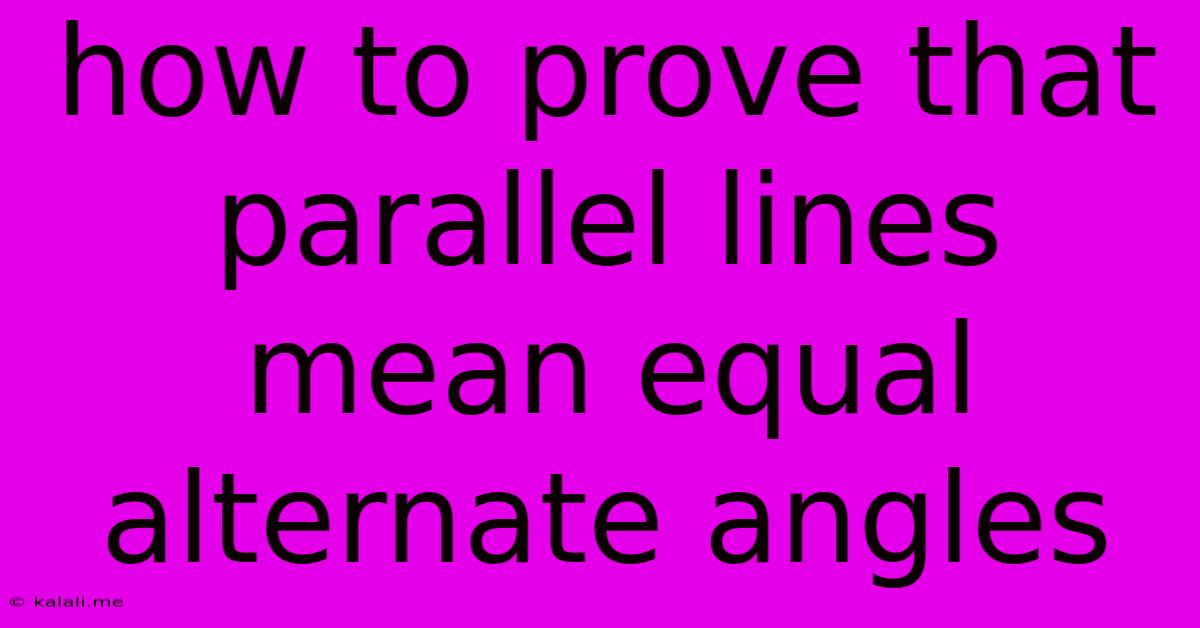How To Prove That Parallel Lines Mean Equal Alternate Angles
Kalali
Jun 04, 2025 · 3 min read

Table of Contents
How to Prove that Parallel Lines Mean Equal Alternate Angles
Meta Description: Learn how to rigorously prove the theorem stating that when two parallel lines are intersected by a transversal, alternate interior angles are equal. This guide provides a clear, step-by-step explanation using Euclidean geometry.
Understanding the relationship between parallel lines and angles is fundamental in geometry. This article will guide you through a clear and concise proof demonstrating that when two parallel lines are intersected by a transversal line, the alternate interior angles are equal. We'll explore the underlying principles of Euclidean geometry to solidify this important concept.
Understanding the Terminology
Before diving into the proof, let's define the key terms:
- Parallel Lines: Two lines that never intersect, regardless of how far they are extended.
- Transversal Line: A line that intersects two or more other lines.
- Alternate Interior Angles: Angles that are on opposite sides of the transversal and inside the two parallel lines.
Consider two parallel lines, l and m, intersected by a transversal line, t. The angles formed by this intersection are what we'll be analyzing.
The Proof: A Step-by-Step Approach
We'll use a proof by contradiction, a common technique in mathematics. This involves assuming the opposite of what we want to prove and showing that this assumption leads to a contradiction, thereby proving our original statement.
1. The Assumption: Let's assume that the alternate interior angles are not equal. Specifically, let's assume that alternate interior angles ∠1 and ∠2 are unequal (∠1 ≠ ∠2).
2. Constructing a Line: Draw a line n through the intersection of lines t and l, such that ∠3 (the angle formed between line n and line l on the same side of t as ∠2) is equal to ∠2 (∠3 = ∠2).
3. The Contradiction: Since ∠3 = ∠2, and we assumed ∠1 ≠ ∠2, then ∠1 ≠ ∠3. This means that line n is not parallel to line m. However, because ∠3 and ∠2 are corresponding angles, and ∠3 = ∠2, by the Corresponding Angles Postulate, line n must be parallel to line m. This is a contradiction!
4. The Conclusion: Our initial assumption that ∠1 ≠ ∠2 must be false. Therefore, the only logical conclusion is that ∠1 = ∠2. This proves that alternate interior angles are equal when two parallel lines are intersected by a transversal.
Extensions and Applications
This fundamental theorem has numerous applications in geometry and beyond:
- Determining Parallelism: If you know that alternate interior angles are equal, you can conclude that the lines are parallel.
- Solving Geometric Problems: This theorem is crucial in solving various geometric problems, such as finding unknown angles and proving other geometric relationships.
- Engineering and Construction: The principles of parallel lines and angles are essential in various fields like engineering and construction for accurate measurements and designs.
This proof highlights the power of logical reasoning in mathematics. By starting with a defined set of axioms and employing sound deduction, we can rigorously establish fundamental geometric truths. Understanding this proof not only strengthens your grasp of geometry but also provides a framework for approaching other mathematical proofs.
Latest Posts
Latest Posts
-
Hot Surface Light Stays On Stove Dangerous
Jun 06, 2025
-
How To Make Sure You Messages Are Stored In Icloud
Jun 06, 2025
-
Symptoms Of Bad Hot Water Heater Element
Jun 06, 2025
-
Baking Soda Is Base Or Acid
Jun 06, 2025
-
Albert Einstein Blind Belief In Authority
Jun 06, 2025
Related Post
Thank you for visiting our website which covers about How To Prove That Parallel Lines Mean Equal Alternate Angles . We hope the information provided has been useful to you. Feel free to contact us if you have any questions or need further assistance. See you next time and don't miss to bookmark.